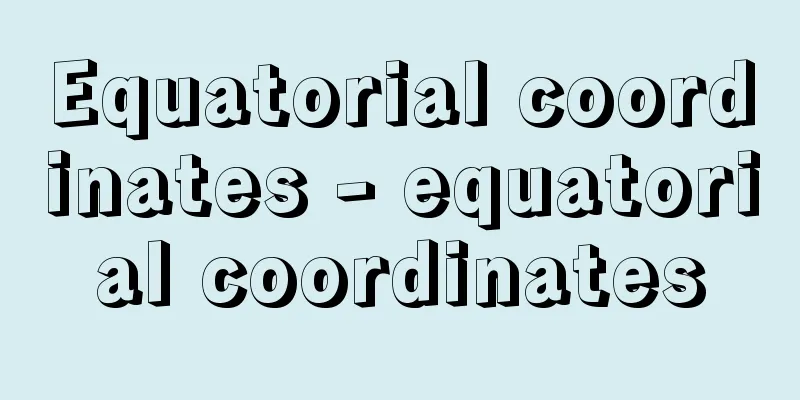Equatorial coordinates - equatorial coordinates

|
A type of celestial coordinate system. It indicates the position of a celestial body on the celestial sphere based on the celestial equator and the vernal equinox. It is similar to the longitude and latitude of the Earth. First, the coordinate equivalent to latitude is the angle (expressed in degrees, minutes, seconds, etc.) measured from the celestial equator along the hour circle (described below) to the celestial body, and is called declination. Next, the angle equivalent to longitude is called right ascension in equatorial coordinates, and is measured eastward from a fixed point on the celestial equator - the vernal equinox. More specifically, right ascension is the angle measured from the vernal equinox along the equator to the point where a great circle (called the hour circle) that passes through the celestial poles (the intersection points of the Earth's rotation axis and the celestial sphere. The celestial equator is a great circle that passes 90 degrees away from these) and the celestial body intersects with the celestial equator. Along with equatorial coordinates, there are hour angles, sidereal time, etc. (As shown in , the meridian is a great circle that passes through the celestial poles and the observer's zenith.) Due to their characteristics, equatorial coordinates are the most convenient for observing the positions and movements of celestial bodies, and are adopted as the basic coordinate system of the universe. However, due to precession and nutation, the celestial poles (and therefore the celestial equator) and the vernal equinox move from moment to moment, and the values of right ascension and declination of celestial bodies change even if they are not moving. Therefore, when expressing the positions of stars, star clusters, nebulae, galaxies, etc. using equatorial coordinates, it is necessary to clarify the specific point in time (called the "epoch") at which the equatorial coordinates are used. [Naoaki Owaki] "Calculating Sunrise and Sunset: How to Calculate the Times of Rising and Setting of Celestial Bodies" by Nagasawa Takumi (1999, Chijin Shokan) [References] | | | | | | |Right ascension + hour angle = sidereal time © Takashi Aoki Equatorial Coordinates (Diagram) Source: Shogakukan Encyclopedia Nipponica About Encyclopedia Nipponica Information | Legend |
|
天球座標の一種。天の赤道と春分点を基準として天球上の天体の位置を表す。地球の経度・緯度と類似している。まず、緯度に相当する座標は、天の赤道から時圏(後述)に沿って天体まで測った角(度、分、秒などの単位の角度で表す)で、赤緯とよばれる。次に経度に相当する角であるが、赤道座標では赤経とよばれ、天の赤道上の一定点―春分点を起点として東回りに測る。詳しくいうと、天の南北両極(地球自転軸と天球との交点。天の赤道はこれらと90度離れたところを通る大円)と天体とを通る大円(時圏という)が天の赤道と交わる点まで赤道に沿って春分点から測った角が赤経である。赤道座標に付随して、時角、恒星時などがある〔にみるように、子午線とは、天の南北極と観測者の天頂とを通る大円〕。赤道座標はその特性上、天体の位置・運動の観測にもっとも便利なもので、宇宙の基本座標系として採用されている。ただし、歳差・章動のため、天の両極(したがって天の赤道)および春分点は時々刻々移動しており、天体がたとえ運動していなくても、その赤経・赤緯の数値は変わっていく。ゆえに赤道座標で恒星、星団、星雲、銀河などの位置を表すときは、「いつの赤道座標か」という特定の時点(これを「元期」という)を明らかにしておかなければならない。 [大脇直明] 『長沢工著『日の出・日の入りの計算――天体の出没時刻の求め方』(1999・地人書館)』 [参照項目] | | | | | | |赤経+時角=恒星時©青木 隆"> 赤道座標〔図〕 出典 小学館 日本大百科全書(ニッポニカ)日本大百科全書(ニッポニカ)について 情報 | 凡例 |
>>: Equatorial Guinea - Guinea Ecuatorial
Recommend
Annunciation lily
…However, because it is somewhat difficult to cul...
The Faerie Queene
A long allegorical poem by the English poet E. Spe...
Ötztal Alps
A mountain range in the eastern Alps that stretch...
Communication policy - komyunikeshonseisaku (English spelling) communication policy
Generally speaking, it is a relatively new concept...
Annaka mine damage - Annaka mine damage
...In 1968, the victims filed a lawsuit demanding...
Altaic peoples - Altaic peoples
A general term for ethnic groups that use Altaic l...
Bertholletia excelsa (English spelling) Bertholletia excelsa
...The seeds of the Brazil nut tree , Bertholleti...
karvan (English spelling)
…From the Persian kārvān, meaning caravan. In Ara...
Red spotted scarab beetle - Red spotted scarab beetle
…The larvae bend strongly ventrally and the abdom...
Flower and bird combination
...Depending on the type of game, points are adde...
English Setter
⇒ English Setter Source: Kodansha Dogs & Cats:...
Katsuji (English) type
Originally, type was the character shape used in ...
Sunfish (manbogai) - Bull Mouth Helmet Shell
A gastropod shell of the family Acanthidae (illust...
Gas field
…A geological layer in which crude oil and gas no...
Tetraneura
...In Tokyo, they are called "Oowata" o...









